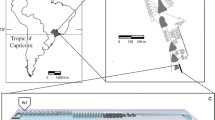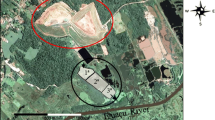Abstract
This paper presents the results of using a pilot-scale-constructed wetland as a tertiary system to simulate the treatment conditions of wastewater effluents from the metal-mechanical industry, aiming to achieve the Brazilian legal standards of phosphorus and nitrogen emission. The macrophytes were placed in 1 m3 polyethylene tanks, daily estimating the treatment of 2 m3 of effluents. The effluents were circulated in a horizontal subsurface flow through a porous matrix of thick sand and gravel, in which the roots of the macrophytes of the species Reed (Scirpus sp.) and Cattail (Typha sp.) were fixed. Monitoring of the pilot plant was performed through a battery of physical–chemical and biological analyses. Despite the load variations and operational problems, the system presented a positive degree of pollutant efficiency removal, especially for phosphorus (73% medium), TKN (61% medium), and NH4–N (56% medium). Peak results were achieved during the last 3 months of monitoring. The chemical analysis of the support layer, plus the root system and aerial portion of the plants, revealed that these wastes could be used as fertilizer.










Similar content being viewed by others
References
APHA, AWWA, & Wef. Standard (1998). Methods for the examination of water and wastewater (20th ed.). Washington: American Public Health Association.
Brazilian Technical Standards Association (1987a). Preservation and sampling techniques of liquid effluents and of water bodies. ABNT NBR 9898. São Paulo.
Brazilian Technical Standards Association (1987b). Determination of the granulometric aggregate composition. ABNT NBR 7217. São Paulo.
Brazilian Technical Standards Association (2004a). Classification of solid wastes. ABNT NBR 10004. São Paulo.
Brazilian Technical Standards Association (2004b). Test method - leaching of wastes. ABNT NBR 10005. São Paulo.
Brazilian Technical Standards Association (2004c). Standard procedure - solubilization of wastes. ABNT NBR 10006. São Paulo..
Brazilian Technical Standards Association (2004d). Standard procedure - sampling of wastes. ABNT NBR 10007. São Paulo.
Campos, J. R. (1999). Wastewater treatment by anaerobic process and provision controlled soil (p. 435). Rio de Janeiro: ABES.
Chavan, P. V., & Dennett, K. E. (2008). Wetland simulation model for nitrogen, phosphorus, and sediments retention in constructed wetlands. Water Air Soil Pollution, 187, 109–118.
Cooper, P., Job, G. D., Green, M. B., & Shutes, R. B. E. (1996). Reed beds and constructed wetlands for wastewater treatment. Marlow: WRc Publications Medmenham.
Curia, A. C. (2003). Characterization of AGCO Corporation’s wastewater treatment plant. Master Thesis, UFRGS - PPGEM.
Erickson, A. J. (2005). Enhanced sand filtration for storm water phosphorus removal. Master of Science. Faculty of the graduate school of the University of Minnesota.
Gerber, M. D. (2002). Treatability effluent parboiled rice on systems with emergent aquatic plants. Master Thesis, UFP.
Gerber, W. D. (2004). Anaerobic-aerobic treatment of industrial wastewater into the environment of close-circuit water. Leon University, Environmental and Biological Science University, Vegetal Biology Department.
Giovannini, S. G. T. (1997). Establishment and development of aquatic macrophytes Scirpus californicus, Typha subulata and Zizaniopsis bonariensis under experimental conditions of different water regimes. UFRGS - IPH.
Goulet, R. R., Pick, F. R., & Droste, R. L. (2001). Test of the first-order removal model for metal retentation in a young constructed wetland. Ecological Engineering, 17, 357–371.
Henry-Silva, G. G., & Camargo, A. F. M. (2006). Chemical composition of floating aquatic macrophytes used to treat of aquiculture wastewater. Planta Daninha, 24(1), 21–28. Minas Gerais.
Hu, C., & Shand, B. (2009). Phosphorus removal performance and mechanisms of a constructed horizontal subsurface flow wetlands treating reclaimed water. Environmental Engineering Science, 26, 1097–1106.
ITRC - The Interstate Technology & Regulatory Council. (2003). Technical and regulatory guidance document for constructed wetlands.
IWA - International Water Association. (2000). Constructed wetlands for pollution control: Processes, performance, design and operation (p. 156). London: IWA.
Jamieson, T. S., Stratton, G. W., Gordon, R., & Madani, A. (2003). The use of aeration to enhance ammonia nitrogen removal in constructed wetlands. Canadian Biosystems Engineering, 45, 1.9–1.14.
Kadlec, R. H. (1998). Chemical, physical and biological cycles in treatment wetlands. Proceedings 6º International Conference on Wetland Systems for Water Pollution Control (p. 229–242). United Kingdom.
Kaick, T. S. V. (2002). Sewerage treatment plant by root zone: a proposal of appropriated technology for basic sanitation in the interior of Paraná. Cent. Fed. Ed. Tec. Paraná, Curitiba.
Kaseva, M. E. (2004). Performance of a sub-surface flow constructed wetland in polishing pre-treated wastewater - a tropical case study. Water Environment Research, 38, 681–687.
Koottatep, T., & Polprasert, C. (1997). Role of plant uptake on nitrogen removal in constructed wetlands located in the tropics. Water Science and Technology, 36(12), 1–8.
Korkusuz, E. A., Beklioglu, M., & Demirer, G. (2005). Comparison of the treatment performances of blast furnace slag-based and gravel-based vertical flow wetlands operated identically for domestic wastewater treatment in Turkey. Ecological Engineering, 5, 1–13.
Lautenschlager, S. R. (2001). Modeling the performance of constructed wetlands. PUC - Hydraulic and Sanitary Department, São Paulo.
Matagi, S. V., Swai, D., & Mugabe, R. (1998). A review of heavy metal removal mechanisms in wetlands. African Journal Hydrobiological Fish, 8, 23–35.
Newman, J. M., Clausen, J. C., & Neafsey, J. A. (2000). Seasonal performance of a wetland constructed to process dairy milkhouse wastewater in Connecticut. Ecological Engineering, 14, 181–198.
Ouellet-Plamondon, C., Chazarenc, F., Comeau, Y., & Brisson, J. (2006). Artificial aeration to increase pollutant removal efficiency of constructed wetlands in cold climate. Ecological Engineering, 27(3), 258–264.
Panigatti, M. C., & Maine, M. A. (2003). Influence of nitrogen species (NH +4 and NO −3 ) on the dynamics of P water-sediment Salvinia Hergozii systems. Hydrobiologia, 492, 151–157.
Platzer, C. (1998). Design recommendations for subsurface flow constructed wetlands for nitrification and denitrification. 6th International Conference on Wetlands Systems for Water Pollution Control Constructed, pp. 253–258.
Poach, M. E., Hunt, P. G., Vanotti, M. B., Stone, K. C., Matheny, T. A., Johnson, M. H., et al. (2003). Improved Nitrogen Treatment By Constructed wetlands receiving partially nitrified liquid swine manure. Ecological Engineering, 20, 183–197.
Rosseau, D. P. L., Vanrolleghem, P. A., & Pauw, N. (2003). Model based design of horizontal subsurface flow constructed treatment wetland: a review. Water Research Number, 38, 1484–1493.
Sakadevan, K., & Bavor, H. J. (1998). Phosphate adsorption characteristics of soils, slags and zeolite to be used as substrate in constructed wetland systems. Water Research, 32(2), 393–399.
Shutes, R. B., Ellis, J. B., Revitt, D. M., & Zhang, T. T. (1993). The use of Typha latifolia for heavy metal pollution control in urban wetlands. Constructed Wetlands for Water Quality Improvement, 407–414.
Sonavane, P. G., Munavalli, G. R., & Ranade, S. V. (2007). Feasibility of constructed wetland treatment system for septic tank effuent. Journal of the IPHE India, 08(3), 32–36.
Sousa, J. T., Haandel, A. V., Lima, E. P. C., & Henrique, I. N. (2004). Use of constructed wetland post-treatment of domestic sewage pretreated in UASB. Sanitary and Environmental Engineer, 9(4), 285–290.
Sperling, M. V. (1996). Principles of biological treatment of wastewater: introduction to water quality and sewage treatment, 2nd edn. DESA, Public University. Minas Gerais, Belo Horizonte, vol. 1, p. 243.
Tegegne, B. M., Bruggen, J. J. A., O'Keeffe, J., & Wasala, W. M. S. W. (2008). A constructed wetland for wastewater treatment emphasis on optimization of nitrogen removal. Institute for Water Education, Unesco. Working Paper Series, vol. 6.
Tunçsiper, B. (2009). Nitrogen removal in a combined vertical and horizontal subsurface flow constructed wetland system. Desalinization, 247, 466–475.
Vymazal, J. (2009). The use constructed wetlands with horizontal sub-surface flow for various types of wastewater. Ecological Engineering, 35, 1–17.
Zhao, Y. Q., Sun, G., & Allen, S. J. (2004). Anti-sized reed bed system for animal wastewater treatment a comparative study. Water Research, 38, 2907–2917.
Zurita, F., Anda, J., & Belmont, M. A. (2009). Treatment of domestic wastewater and production of commercial flowers in vertical and horizontal subsurface-flow constructed wetlands. Ecological Engineering, 35, 861–869.
Author information
Authors and Affiliations
Corresponding author
Rights and permissions
About this article
Cite this article
Curia, A.C., Koppe, J.C., Costa, J.F.C.L. et al. Application of Pilot-Scale-Constructed Wetland as Tertiary Treatment System of Wastewater for Phosphorus and Nitrogen Removal. Water Air Soil Pollut 218, 131–143 (2011). https://doi.org/10.1007/s11270-010-0629-0
Received:
Accepted:
Published:
Issue Date:
DOI: https://doi.org/10.1007/s11270-010-0629-0




